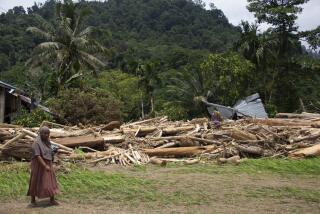Encroaching Desert Plagues Bangladesh
- Share via
RANGPUR, Bangladesh — Overcrowded and poverty-stricken Bangladesh, a prey to frequent natural disasters, may eventually lose half its habitable land to desert, environmental experts warn.
“We are facing a threat of desertification through much of the country’s northern areas,” said Abdul Mukit Khan, a senior forestry official.
“There is no denying this. We are already in for trouble,” he said in a recent interview.
Forests cover only 2% of land in the north, compared with 7% elsewhere in the country, which is far too little, he said.
Environment and Forest Minister Abdullah Al-Noman told a seminar in Rangpur in northern Bangladesh in October that the country needed 25% of its 55,598 square miles of land under forest to maintain a balance of nature.
About 21% of its land area was forested in 1947, officials say. They blame the deforestation mainly on indiscriminate felling of trees for firewood and other domestic use and the growing need for human habitation.
The annual rate of population growth in Bangladesh, home to 110 million of the world’s poorest people, was 2.8% in 1989. By contrast, the rate in the United States was .6%.
Khan listed various factors as contributing to a gradual desertification: declining vegetation, poor efforts to create new forests, a population increase disproportionate to natural resources, diminishing underground water supplies due to excessive irrigation and, finally, poverty.
“The desertification process has already started and the above reasons are only accelerating it,” Khan said.
Agriculture Minister Majedul Huq has said Bangladesh was being denuded of forests faster than expected, exposing the country to the dangers of more natural disasters.
Bangladesh’s worst cyclone on record killed more than 138,000 people on the coast and offshore islands in April. Tornadoes and floods are an annual feature in this mostly flat and alluvial land crisscrossed by numerous rivers.
Environmentalists say much of the losses from natural disasters, especially cyclones and tidal waves, could have been averted if the country had a forest shield.
The main rivers in the north--the Jamuna, Padma, Brahmaputra and Teesta--are all silting up and overflow their banks during the monsoon season.
In winter, riverbeds dry up and virtually no crops grow along their sandy shores.
Forestry official Mohiuddin Ahmed blamed “poor political commitment” by successive governments.
“They just cared for their power, comfort and financial gains. They never sincerely thought if the nation itself would survive,” he said.
Bangladesh started a Community Forestry Program in 1981 with funds from the Asian Development Bank, hoping to motivate villagers and townspeople to plant trees in their back yards, along the highways and on all fallow land.
“The rate of success has been very limited as no one realized it would help avert a grave situation they are heading for,” Khan said.
Some new forests disappeared because the wrong plant species were chosen.
Officials said huge areas in the 2,250-square-mile Sunderban tidal forest on the Bangladesh coast have been cleared of valuable trees by unscrupulous timber traders and officials.
“Unless this is stopped immediately, there will be hardly anything to confront killer waves coming from the Bay of Bengal,” an official in southern Khulna district told reporters recently.
More to Read
Sign up for Essential California
The most important California stories and recommendations in your inbox every morning.
You may occasionally receive promotional content from the Los Angeles Times.









